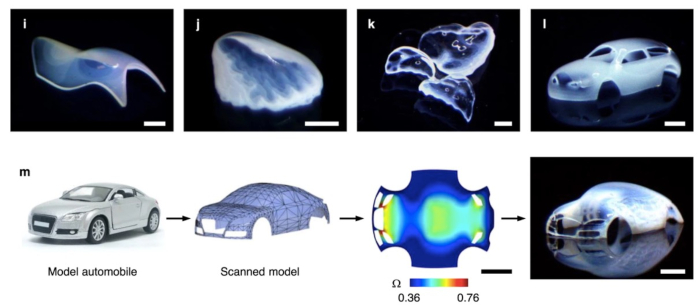
Researchers from the University of Texas at Arlington (UTA) have found a way to create synthetic 2D materials that are able to transform into complex 3D shapes. These materials have the ability to mimic the way that living organisms expand and contract soft tissues. The 2D materials are therefore able to achieve complex 3D movements and functions. The programming of 2D materials to morph into 3D shapes is emerging as a paradigm in additive manufacturing. 2D materials are thin sheets of material, made up entirely of their surface. These materials are often only a single atom thick and tend to be highly flexible and porous while also rigid and strong. For example, graphene is the thinnest known 2D material and is stronger than steel.
The research team was headed by Kyungsuk Yum, an associate professor in the Materials Science and Engineering Department, and partially relied on digital light projection lithography, a 4D printing method that Yum had developed along with his colleagues a few years prior. Yum commented on this project explaining, “there are a variety of 3D-shaped 2D materials in biological systems, and they play diverse functions”. Yum continued, “biological organisms often achieve complex 3D morphologies and motions of soft slender tissues by spatially controlling their expansion and contraction. Such biological processes have inspired us to develop a method that programs 2D materials with spatially controlled in-plane growth to produce 3D shapes and motions.”

3D scanning and printing of a model automobile. (Credit: UTA)
Amirali Nojoomi, a former graduate student of Yum and author of the paper expanded on the team’s methodology: “Our 2D-printing process can simultaneously print multiple 2D materials encoded with individually customized designs and transform them on demand and in parallel to programmed 3D structures. From a technological point of view, our approach is scalable, customizable, and deployable, and it can potentially complement existing 3D-printing methods.” Using this method and a desktop 3D scanner (NextEngine), the research team were able to successfully print several parts including the model of an automobile, shown in the picture above.
The new technologies enabled by the discovery that 2D materials could be programmed to morph into 3D shapes will have strong repercussions on development in soft robotics, deployable systems, and biomimetic manufacturing. “Dr. Yum’s innovative research has many potential applications that could change the way we look at soft engineering systems,” commented Stathis Meletis, chair of the Materials Science and Engineering Department. “His pioneering work is truly groundbreaking.”


